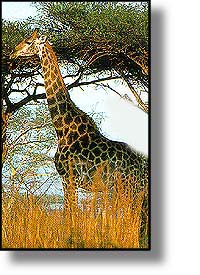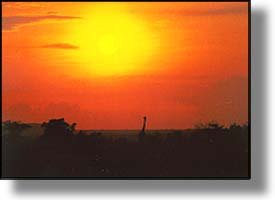South Africa
Adventure Travel in South Africa | Africa Homepage | Geographia Home
 South Africa is
one of the most geographically varied countries of the African
continent, comprising territory that ranges from the rolling,
fertile plains of the highveld and the wide open savanna of the
Eastern Transvaal to the Kalahari desert
and the peaks of the Drakensberg Mountains. While all of its
diverse regions offer ample opportunities for adventure travel,
the focus in South Africa--as in much of sub-Saharan Africa--is
the safari. In addition to possessing two of the world's most
renowned wildlife reserves, the Kruger and the Kalahari Gemsbok
National Parks, the country contains over a dozen smaller regional
parks and reserves. In addition, with its excellent road and
rail systems, its abundance of top-rated accommodations, and
its bountiful farmlands and vineyards, South Africa allows visitors
ample opportunity for more luxurious comfort along with adventuresome
excitement.
South Africa is
one of the most geographically varied countries of the African
continent, comprising territory that ranges from the rolling,
fertile plains of the highveld and the wide open savanna of the
Eastern Transvaal to the Kalahari desert
and the peaks of the Drakensberg Mountains. While all of its
diverse regions offer ample opportunities for adventure travel,
the focus in South Africa--as in much of sub-Saharan Africa--is
the safari. In addition to possessing two of the world's most
renowned wildlife reserves, the Kruger and the Kalahari Gemsbok
National Parks, the country contains over a dozen smaller regional
parks and reserves. In addition, with its excellent road and
rail systems, its abundance of top-rated accommodations, and
its bountiful farmlands and vineyards, South Africa allows visitors
ample opportunity for more luxurious comfort along with adventuresome
excitement.
Location, Geography, & Climate
South Africa is located, as one might expect, on the southern tip of Africa. It is bordered by the Atlantic Ocean on the west, the Indian Ocean on the south and east. Along its northern border, from west to east, lie Namibia, Botswana, and Zimbabwe, and to the northeast are Mozambique and Swaziland. Wholly-enclosed by South Africa, and situated in its eastern central plain, is the independent kingdom of Lesotho.
Almost all of South Africa's 472,000 square miles (1.2 million sq. km.) lie below the Tropic of Capricorn, and the country is geographically composed of three primary regions: an expansive central plateau, a nearly continuous escarpment of mountain ranges that ring the plateau on the west, south, and east, and a narrow strip of low-lying land along the coast. Most of the central plateau (and most of the country) consists of high (4,000-6,000 ft/1,220-1,830 m), rolling grassland known as highveld. The highest points of the mountainous escarpment are found in the stunning Drakensberg (dragon's back) Mountains, where the tips of dragon's back can exceed heights of 10,000 ft (3,050 m).
In the northwest, South Africa's Kalahari Gemsbok National Park, one of the continent's largest game reserves, extends into the red sands and scrub grasslands of the great Kalahari Desert. In the northeast, the highveld plateau descends to the Bushveld and Limpopo River basins. The Bushveld comprises South Africa's extensive savanna, in which is found the country's marvelously rich and diverse game reserve, the world-renowned Kruger National Park.
Although South Africa's climate varies considerably across its various regions and environments, temperatures remain comfortable throughout the year. The best time to visit for safari is between May to August, when there is less rain and much less dense vegetation, making animal sightings far more frequent.
History & People
 South
Africa's population of forty million is three-quarters black
(African) and about 15% white (European), with the remaining
10% comprised of people of mixed white, Malayan, and black
descent and people of Asian (mostly Indian) descent. The African
majority is composed of many different ethnic groups, the largest
of which are Zulu, Xhosa, Tswana, and Bapedi. Until very recently,
the country's racial divisions were harshly enforced as part
of the government's official policy of Apartheid, or apartness.
Although the government began to dismantle apartheid in 1989
after prolonged resistance, protest, and international economic
sanctions, racial inequality remains pronounced in South Africa.
South
Africa's population of forty million is three-quarters black
(African) and about 15% white (European), with the remaining
10% comprised of people of mixed white, Malayan, and black
descent and people of Asian (mostly Indian) descent. The African
majority is composed of many different ethnic groups, the largest
of which are Zulu, Xhosa, Tswana, and Bapedi. Until very recently,
the country's racial divisions were harshly enforced as part
of the government's official policy of Apartheid, or apartness.
Although the government began to dismantle apartheid in 1989
after prolonged resistance, protest, and international economic
sanctions, racial inequality remains pronounced in South Africa.
Adventure
Travel in South Africa | Africa Homepage
Copyright (c) 1998-2005 interKnowledge Corp. All rights reserved.